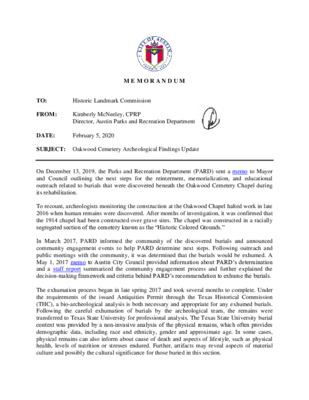2.A - Oakwood Cemetery (2) — original pdf
Backup

M E M O R A N D U M TO: FROM: Historic Landmark Commission Kimberly McNeeley, CPRP Director, Austin Parks and Recreation Department February 5, 2020 DATE: SUBJECT: Oakwood Cemetery Archeological Findings Update On December 13, 2019, the Parks and Recreation Department (PARD) sent a memo to Mayor and Council outlining the next steps for the reinterment, memorialization, and educational outreach related to burials that were discovered beneath the Oakwood Cemetery Chapel during its rehabilitation. To recount, archeologists monitoring the construction at the Oakwood Chapel halted work in late 2016 when human remains were discovered. After months of investigation, it was confirmed that the 1914 chapel had been constructed over grave sites. The chapel was constructed in a racially segregated section of the cemetery known as the “Historic Colored Grounds.” In March 2017, PARD informed the community of the discovered burials and announced community engagement events to help PARD determine next steps. Following outreach and public meetings with the community, it was determined that the burials would be exhumed. A May 1, 2017 memo to Austin City Council provided information about PARD’s determination and a staff report summarized the community engagement process and further explained the decision-making framework and criteria behind PARD’s recommendation to exhume the burials. The exhumation process began in late spring 2017 and took several months to complete. Under the requirements of the issued Antiquities Permit through the Texas Historical Commission (THC), a bio-archeological analysis is both necessary and appropriate for any exhumed burials. Following the careful exhumation of burials by the archeological team, the remains were transferred to Texas State University for professional analysis. The Texas State University burial context was provided by a non‐invasive analysis of the physical remains, which often provides demographic data, including race and ethnicity, gender and approximate age. In some cases, physical remains can also inform about cause of death and aspects of lifestyle, such as physical health, levels of nutrition or stresses endured. Further, artifacts may reveal aspects of material culture and possibly the cultural significance for those buried in this section. The process does not provide information about the individual identities of the people who were discovered. The archeological report is under review by the THC, and PARD is anticipating release to the public in March 2020. The next step in the process will be the reinterment of the remains within Oakwood Cemetery, which is anticipated to take place in spring 2020. PARD is currently finalizing a contract with a firm for archeological services to provide oversight of the reinternments. As recommended in the 2017 public engagement process, the goal is to reinter all burials in proximity to the Oakwood Chapel. Should reinterment at Oakwood Cemetery not be feasible following archeological analysis, PARD will propose alternatives that will still allow for commemoration and memorialization on site. Once the reinterment process is completed, the burials will be memorialized with commemorative markers. Following the reinterment, PARD will initiate a commemoration process. This work is still in the planning phase and more information will be forthcoming in spring 2020. The commemorative process offers an opportunity for reflection about a past injustice while honoring the people who were rediscovered during the Chapel rehabilitation. This process may include: • Ceremony to honor the individuals who were rediscovered and reinterred in Oakwood Cemetery. At the same time, PARD will dedicate a permanent memorial that explains the exhumation and reinterment process and honors the individuals who were rediscovered in this process. • An educational symposium to allow for further exploration of the cultural context of the people who have been rediscovered and reinterred. The symposium will allow community members to hear from expert archeological professionals to provide context for the report and allow for community conversations about the findings. • A digital exhibit at Oakwood Chapel that interprets the archeological findings. • An interpretive plan and signage for the “Historic Colored Grounds” as recommended in the Historic Cemeteries Master Plan. The archeological report will help inform the opportunities to honor and interpret this historically significant section of the cemetery. PARD is aware of community concerns related to the replacement of infrastructure associated with the chapel restoration. As required by the Antiquities Permit for the restoration project, the archeology firm that was contracted by the City of Austin has submitted final reports to the THC. PARD will continue to update the Historic Landmark Commission as additional information becomes available. Should your commission prefer a briefing once the archeological reports are released to the public, PARD would be happy to accommodate that request. Should you have any questions, please contact me at (512) 974-6717. cc: Spencer Cronk, City Manager Nuria Rivera-Vandermyde, Deputy City Manager Chris Shorter, Assistant City Manager